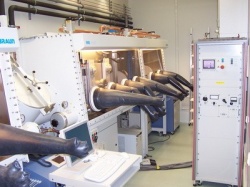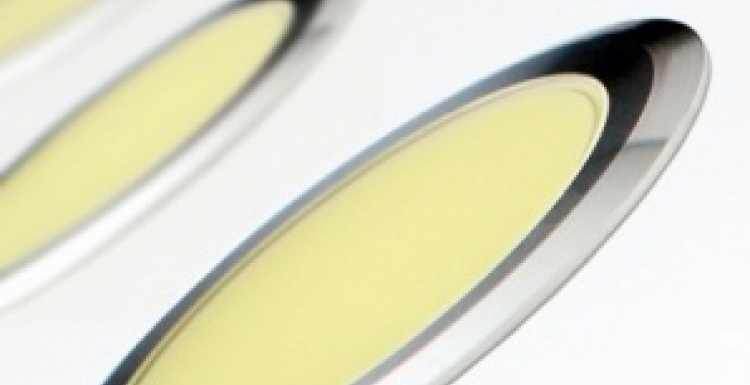Interview • 01.04.2012
LED is a point light source, OLED is great for luminous surfaces
iXtenso interview with Dr. Armin Wedel, Fraunhofer Institute for Applied Polymer Research in Potsdam, Germany

After the LED, now the OLED, the organic light-emitting diode is being developed. What is already feasible with it and what are the advantages of the luminous, thin components? Dr. Armin Wedel, who researches the technical specifications for OLEDs in lighting, answers our questions. He believes that only a small part of the possible fields of application are identified.
What fields of application do you see for OLEDs?
Basically we see three fields of application: lighting, displays and advertisement – signage – with OLEDs. Germany and Europe have focused on OLED lighting, because this is also where the big “players” like Osram and Philips are. OLEDs will not replace conventional lamps, but they will complement them like LED lighting does now. Yes, interactive lighting will be available with OLEDs, since it allows you to ideally combine sensor functionalities with each other.
What are the differences between LED and OLED?
The biggest difference is in the type of light emittance. An LED is a point light source while an OLED is a surface light source. An LED is widened by optical aids such as lens structures for instance. An OLED no longer needs a reflector, because it emits over the entire surface.
When will organic light-emitting diodes be ready for the market?
There are already many products on the market in the area of displays, for example for cell phones, MP3 Players and digital cameras. The potential is large and is – in my book – not even utilized by 20 percent yet. Until now there are only a few OLED TV sets on the market, but manufacturers like Samsung for instance are currently investing in production facilities.
When do you expect large-scale OLED lighting for entire walls or ceilings?
Although the realization of light-emitting wallpaper or light-emitting windows at night is still a vision of the future, OLEDs move into lighting with designer products. You see this with lamps for example. However, at the moment we also notice another interesting development: now there are LED backlights integrated into the relatively thin LCD TVs, which could also be excellently suited for large scale lighting. This begs the question whether this type of lighting will even find its way first into the market on a large scale.
How efficient are OLEDs at the moment?
Organic light-emitting diodes today reach efficiencies that compare to fluorescent lamps. OLEDs however still remain an electrically driven component. This makes this technology for OLED displays differ fundamentally from the LCD monitors.
What’s the situation with heat, IR and UV light emissions?
For the retail market it is crucial that the temperature of OLED lighting for merchandise presentations can be managed. What’s also important is whether the emission of OLED lighting is harmful for instance in refrigerated display cases or in unpacked foods. Since OLEDs however emit light solely in the visible spectral range, no interferences are to be expected.
What is the environmental audit during production and recycling of OLEDs?
Since an OLED display is a self-illuminating panel, compared to LCD it does not require background lighting. That’s why the environmental audit turns out significantly better.
OLEDs contain no toxic materials – as opposed to energy-efficient lamps. OLEDs only consist of carbon, hydrogen and several other elements (such as oxygen or sulfur for instance). In addition, metals and oxides are applied, for example indium or tin oxide which today is also being used in LCD TVs.
Designers continuously develop new light applications. What do designers want from you and what is feasible?
We want close collaboration with the designers. We are sure that not all possibilities for the use of OLEDs are already being recognized or known. The design leeway is very large and there are many great ideas. As always with a new technology, there are basic conditions that needless to say also limit the design.
What are you currently working on? What are still the shortcomings of OLEDs at this point in time?
We are primarily working on the establishment of printing technologies for the materials that are needed in OLEDs. Even though at the moment the most efficient OLEDS that are already being used in products are manufactured with vapor coating, more cost-efficient processes are needed however, especially for larger surfaces.
Are you going to visit the light+building trade fair in Frankfurt and what will you have a look at?
No, we are not just yet visiting the light+building trade fair, but we are in close contact with designers and manufacturers of lighting. We are presently working on the implementation of demonstrator equipment, on which we then are able to make prototypes for the users. We are expecting corresponding orders in this area.
Interview by René Schellbach, iXtenso.com
01/04/2012
Link tip:
www.oled-research.com
http://www.iap.fraunhofer.de/fb2/index.html



